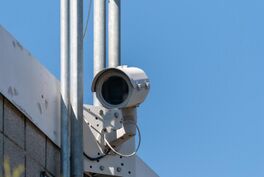Software:Hyper-surveillance
Hyper-surveillance is the intricate surveillance of an entire or a substantial fraction of a population in order to monitor that group of citizens that specifically utilizes technology and security breaches to access information.[1] As the reliance on the internet economy grows, smarter technology with higher surveillance concerns and snooping means workers to have increased surveillance at their workplace.[2] Hyper surveillance is highly targeted and intricate observation and monitoring among an individual, group of people, or faction.[3]
History
In the middle of the 1970s, the American penal system or prison system expanded rapidly.[4] As a result, 1 in 35 adults are in correctional supervision nationwide. The surveillance systems has created targeted and specific supervision.[5] The use of surveillance systems has been targeted against black and Latino men. Consequently, men of color are found to be stopped by police at higher rates. For example, in some neighborhoods, police stop over 500 out of 1000 residents in their lifetime due to hyper surveillance systems.[6]
Hyper surveillance extends beyond the crime control agents and police system as it has been documented in schools, community organizations, and other places.Research finds that hyper surveillance can lead to targeted and specific focus on an individual leading to profiling and predictive policing.[7]
Technology
Facial recognition systems
Constructed through computer programs, facial recognition systems analyze images and biometrics of human faces for the purpose of identification.[8] Compared to other facial systems, recognition software has been used for surveillance and security.[9] Alongside public video cameras, they can be used in a passive structure. Therefore, facial recognition software can be used without the knowledge or consent of a person.[10]
Practically, this technology can be used in state centers, offices, and workplaces. State departments possess photographs of constituents and utilize this information as a resource alongside public surveillance tools to create a system of identification and tracking.[11]
Mobile tracking systems
Mobile phone tracking is a system and process that identifies the location of a mobile phone.[12] It specifically locates the phone through radio signals or through the internal built GPS system.The technology has been used for observing objects or people on the move through specific and ordered locational processing.[13]
Use
A consumer technology that has created hyper surveillance technology is Clearview AI.[14] Some advantages that Clearview AI possess include security and efficiency. Using the technology, law enforcement is able to detect shoplifters, sex traffickers, child abusers, or homicide cases.[15] The software allows enforcement to a database of over three billion pictures allowing police to identify suspects efficiently.[16] However, there are multiple potential negatives including personal abuse, racial bias, inaccurate results, and data security. With access to millions of images, law enforcement could abuse the technology to identify romantic partners or foreign governments can identify people of social status to blackmail. The availability of information makes it more difficult for individual security.[17] In addition, Clearview AI has been proven to mistaken or misidentify suspects before.[18] The use of facial recognition technologies have biases leading to misclassifications causing wrongful arrests. In fact, the company stated that the tool finds matches 75% of the time.[7] Therefore, there are situations where data is inaccurate. A major concern with Clearview AI and facial recognition systems is the data security. In the past, Clearview AI has been hacked and the client base list has been leaked.[12]
References
- ↑ Campos-Manzo, Ana Lilia; Flores, Marisol; Pérez, Denise; Halpert, Zoe; Zevallos, Kevin (2020-07-01). "Unjustified: Youth of Color Navigating Police Presence Across Sociospatial Environments" (in en). Race and Justice 10 (3): 297–319. doi:10.1177/2153368717741346. ISSN 2153-3687.
- ↑ Glover, Karen S. (2008-01-01), Deflem, Mathieu, ed., "Citizenship, hyper-surveillance, and double-consciousness: Racial profiling as panoptic governance", Surveillance and Governance: Crime Control and Beyond, Sociology of Crime, Law and Deviance (Emerald Group Publishing Limited) 10: pp. 241–256, doi:10.1016/S1521-6136(07)00211-4, ISBN 978-0-7623-1416-4, https://doi.org/10.1016/S1521-6136(07)00211-4, retrieved 2020-12-09
- ↑ Gidaris, Constantine (2020-03-01). "The Carceral Airport". Public 30 (60): 76–91. doi:10.1386/public_00007_7. https://www.ingentaconnect.com/content/intellect/public/2020/00000030/00000060/art00007;jsessionid=831l24nqsppu.x-ic-live-01.
- ↑ "UCLA professor explains hyper-surveillance of black males". https://www.statepress.com/article/2015/04/ucla-professor-explains-hyper-surveillance-of-black-males.
- ↑ Reed, Andrew (2019-10-24). "Reed '21: Preventing a new era of hyper-surveillance" (in en-US). https://www.browndailyherald.com/2019/10/24/preventing-new-era-hyper-surveillance/.
- ↑ Jeffries, Fiona (2011-04-01). "Saying Something: The Location of Social Movements in the Surveillance Society". Social Movement Studies 10 (2): 175–190. doi:10.1080/14742837.2011.562362. ISSN 1474-2837. https://doi.org/10.1080/14742837.2011.562362.
- ↑ 7.0 7.1 Ohm, Paul (November 1, 2018). "The Many Revolutions of Carpenter". https://osf.io/preprints/lawarxiv/bsedj/.
- ↑ Odella, Francesca. "Privacy Awareness and the Networking Generation" (in English). https://www.igi-global.com/gateway/chapter/213856.
- ↑ Pina, Pedro. "Electronic Surveillance, Privacy and Enforcement of Intellectual Property Rights : A Digital Panopticon?" (in English). https://www.igi-global.com/gateway/chapter/60988.
- ↑ "Facial Recognition » Avigilon" (in en). 2020-04-23. https://www.avigilon.com/products/ai-video-analytics/facial-recognition.
- ↑ "SSRN Electronic Library". https://papers.ssrn.com/sol3/papers.cfm?abstract_id=3273483.
- ↑ 12.0 12.1 Capers, I. Bennett (2019), Miller, Eric J.; Lave, Tamara Rice, eds., "Citizenship Talk", The Cambridge Handbook of Policing in the United States, Cambridge Law Handbooks (Cambridge: Cambridge University Press): pp. 473–490, ISBN 978-1-108-42055-6, https://www.cambridge.org/core/books/cambridge-handbook-of-policing-in-the-united-states/citizenship-talk/FEB9CAC4EC34467A2274AFC371AF42CA, retrieved 2020-12-09
- ↑ Wilcox, Walter M. (2019-08-23). "Quantum Particle Scattering" (in en). Quantum Principles & Particles. pp. 429–487. doi:10.1201/b22285-11. ISBN 9781138090439. https://www.taylorfrancis.com/. Retrieved 2020-12-09.
- ↑ Zhang, Y.; Li, M.; Dong, Z. Y.; Meng, K. (June 2019). "Probabilistic anomaly detection approach for data-driven wind turbine condition monitoring". CSEE Journal of Power and Energy Systems 5 (2): 149–158. doi:10.17775/CSEEJPES.2019.00010. ISSN 2096-0042.
- ↑ Giroux, Henry A. (2015-03-04). "Totalitarian Paranoia in the Post-Orwellian Surveillance State". Cultural Studies 29 (2): 108–140. doi:10.1080/09502386.2014.917118. ISSN 0950-2386. https://doi.org/10.1080/09502386.2014.917118.
- ↑ Timan, Tjerk; Albrechtslund, Anders (2018-06-01). "Surveillance, Self and Smartphones: Tracking Practices in the Nightlife" (in en). Science and Engineering Ethics 24 (3): 853–870. doi:10.1007/s11948-015-9691-8. ISSN 1471-5546. PMID 26319296.
- ↑ Wittenberg, David (1970-01-01). "Seeing around the next corner" (in en). Science Fiction Film & Television 12 (2): 195–223. doi:10.3828/sfftv.2019.12. http://www.liverpooluniversitypress.co.uk/journals/article/21002. Retrieved 2020-12-09.
- ↑ Peters, Najarian (2020-01-01). "The Right to Be and Become: Black Home-Educators as Child Privacy Protectors". Michigan Journal of Race and Law 25 (1): 21–60. doi:10.36643/mjrl.25.1.right. ISSN 1095-2721. https://repository.law.umich.edu/mjrl/vol25/iss1/3.
 |


